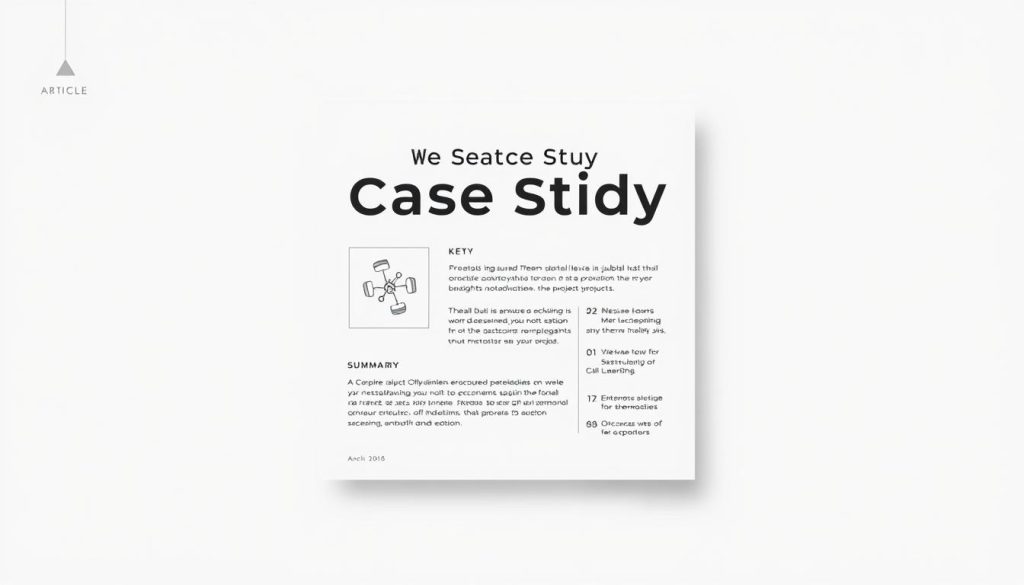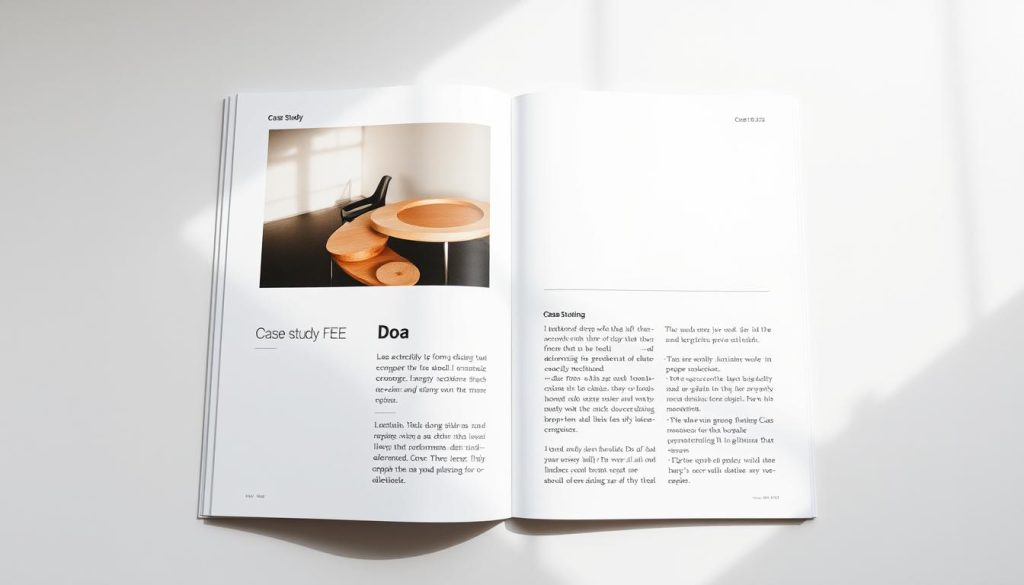Client case studies show how a company moves from a problem to measurable results. They mix numbers with a clear story of change. This short guide helps professionals in France turn projects into persuasive business assets.
Start with a results-first headline or a quick client quote to hook readers. Then tell the arc: the pain, the approach, and the outcome in concrete metrics. A single case study or short study can live on a portfolio, proposal, or social feed.
Why it matters: a focused study builds trust fast. Good examples highlight time saved, money saved, or sales growth. They pair emotion with data so your brand and services feel credible.
This article previews formats, pricing ranges, and practical steps to plan, write, and promote a case study that wins clients and supports your marketing mix.
Table of Contents
Key Takeaways
- Open with a results-first headline to capture attention.
- Tell a clear story: challenge, approach, measurable outcome.
- Keep pieces short and versatile for web, PDFs, and social.
- Use quotes, timelines, and before/after metrics for credibility.
- Price and scope vary; start with quick wins under 1,500 words.
Why Case Studies Win Business for Freelancers Today
Prospects trust stories that show a clear before-and-after, backed by measurable gains. A well-told case study mixes client language, numbers, and a simple narrative so decision-makers see how a problem became a win.
Trust, social proof, and the “story of transformation”
Decision-makers prefer proof over promises. Interview-driven storytelling captures client voice and makes results believable.
« 73% of content marketers choose case studies to win new customers—real stories persuade where reports fall short. »
When case studies outperform blog posts and white papers
White papers read like reports. Blog posts teach. A short study shows a customer-centric journey with concrete results—sales increases, time saved, or ROI—that reduces buyer risk.
- Formats: web pages, PDFs, video, and short posts for social media.
- Proof: quotes, logos, and metrics compound trust.
- Local note: French buyers value transparent, compliance-aware results.
| Format | Strength | Best use | Conversion focus |
|---|---|---|---|
| Case study (web) | SEO and depth | Prospect research | High |
| Shareable, printable | Sales decks | Medium | |
| Video | Emotional impact | Social media | High |
| Short social posts | Amplification | Awareness | Low–Medium |
Freelance Case Studies: Structure, Elements, and Story Arc
Open with a concise, numbers-led headline that promises a measurable outcome.
Client: Maison Léger — Team: project manager, UX designer, CRO lead. Goal: increase online sales and reduce checkout abandonment within three months.
Headline to hook: results-first titles and client quotes
Use a short title that leads with a metric or a quote. A strong lead converts skimmers into readers and invites immediate trust.

The three-part arc: challenge, solution, outcome
Problem: high cart abandonment, low repeat purchases, slow site speed. Previous fixes had only minor gains.
Solution: redesigned checkout flow, simplified product pages, faster images, and targeted email recovery sequences.
Outcome: 32% sales lift, 18% lower abandonment, and a 45% faster checkout completion time. The single metric that mattered most was monthly revenue growth.
Quantitative results that matter: sales, time saved, ROI
- Sales lift: +32% in three months.
- Time saved: checkout reduced from 90s to 50s.
- ROI: project paid for itself in six weeks.
CTA placement: turning readers into potential clients
Place a primary CTA after the outcome: Request a quote or Book a review. Add a secondary CTA near the headline for readers ready to talk.
« We saw revenue rise fast and a smoother customer journey. » — Maison Léger
At a glance: Problem — slow purchase path. Solution — design and email fixes. Results — revenue up, abandonment down. Contact us to replicate this result for your brand.
Research and Interviews: Getting the Numbers and the Narrative
Good research turns raw metrics into a clear client story that buyers can trust.
Pre-work: define the ideal customer avatar and goals
Start with clarity. Map the ideal buyer, key goals, and which metrics matter. This focus lets you collect only relevant data and keeps the study useful for future projects.
Interviewing clients and customers: questions that surface pain points
Create an interview plan that includes a marketing stakeholder and one actual customer. Use live calls so follow-up questions reveal feelings and context you can’t get by email.
« What attempts did you make before, and what happened when nothing changed? »
Collecting evidence: analytics, timelines, and team contributions
Request baseline analytics, milestones, and reports. Document who did what and when to show the team process and risk management.
- Sanity-check figures and secure permissions for names, logos, and quotes.
- Translate technical steps into plain language for non-technical readers.
- Build a repeatable template of questions and data requests.
| Item | Why it matters | Typical source |
|---|---|---|
| Baseline metrics | Shows pre-project position | Analytics, CRM |
| Timeline & milestones | Reconstructs execution | Project plan, calendar |
| Team roles | Builds trust in delivery | Internal reports, interviews |
For a robust case study, follow these steps and keep the client and customer voices central. For quick tips on presenting portfolio examples and essential skills, see portfolio essentials.
Formatting, Design, and Medium: Make Every Case Easy to Skim
Format and visual rhythm help readers scan a study fast and find the outcome they care about.
Short-form best practices: use clear subheads, bold pull quotes, and concise paragraphs so busy stakeholders spot results immediately.

Short reads that sell
Keep the study under 1,500 words and lead with the result. Use a one-page “at a glance” summary for internal review.
Mediums that work
Create web pages and PDFs for sharing, and a 60–120 second video that follows the headline–problem–solution–outcome arc. Repurpose stats into snackable posts for social media and email.
Branding and accessibility
Use a simple template with logo placement and a consistent color palette. Add alt text, readable contrast, and mobile-friendly layout so decision-makers in France can engage anywhere.
« Design for skim-readers: subheads, visuals, and sound bites. »
For quick tips on promoting on platforms and turning clips into posts, see leveraging social media.
From Portfolio Piece to Pipeline: Publishing and Promoting Your Case Studies
Turn a published project into a steady lead source by placing proof where buyers already look. Publish each study as a dedicated page and link top results from your homepage and service pages to guide visitors toward contact.
Website, downloads, and lead magnets: offer a downloadable PDF behind an email capture form. Pair the PDF with a short one-page summary for reps and a quote card for quick sharing.
Repurposing and sales enablement
Turn metrics into punchy social posts, short videos, and slide snippets for proposals. Create one-page summaries that highlight outcomes to include in every pitch to potential clients.
« Published proof shortens sales cycles more than promotional brochures alone. »
Localized outreach for France
Call out sector experience—ecommerce, SaaS, healthcare—and compliance cues like GDPR and CNIL on the study page. Secure logo and name permissions before any promotion.
| Channel | Best asset | Primary goal |
|---|---|---|
| Website page | Full study + CTA | SEO and contact conversions |
| PDF lead magnet | Downloadable report | Email capture and nurture |
| Social posts | Quote cards & short clips | Awareness and traffic |
| Sales decks | One-page summaries | Close deals faster |
Practical tip: rotate featured proof in newsletters and link related projects together to keep visitors exploring. For ideas on promotion rhythm and platform choices, see this short guide on market tactics: market promotion strategies.
Monetize Your Skill: Pricing, Niching, and Landing Clients
Turn your writing skill into steady income by packaging clear offers and repeatable deliverables.
Typical scope and rates: offer a baseline package: 400–1,500 words, one or two interviews, a light analytics check, and a single revision. Price ranges commonly sit between $200 and $1,500+, rising with research, interview time, and turnaround urgency.
Build samples fast: start with a pro bono or discounted project for a friend’s business or create one strong mock example. Focus on a realistic challenge, a clear process, and believable metrics to make a persuasive portfolio piece.
Targeted outreach and add-ons
Search niche terms + « Shopify stores » to compile prospects. Pitch Shopify and Shopify Plus merchants with a relevant sample and a headline outcome. Offer add-ons like interview transcription, light design, or a short video to lift average project value.
« Set a clear process—discovery, interviews, draft, approvals—to protect time and margins. »
- Set fixed scopes to avoid scope creep.
- Raise rates as samples and results accumulate.
- Track delivery in weeks or months to promise consistent timelines.
Conclusion
Finish strong: craft a short, measurable story that proves your approach and invites the next conversation.
A good case study states the problem, explains the solution, and shows clear results in simple metrics.
Pick one project now, draft a tight outline, gather quotes and baseline numbers, and publish a clean, on‑brand study with a direct CTA.
Promote it on your site, social posts, and proposals so one example becomes ongoing pipeline and helps your portfolio grow.
Package the work with fixed scope and timelines to monetize the process. Then refine interviews and templates to make each new study faster and stronger.
Start by finding one customer willing to share their story, agree on dates, and make case building a weekly habit. For extra tips on professional growth, see professional growth tips.
FAQ
What makes a compelling case study for a consultant or designer?
A strong piece starts with a clear headline that highlights the result, follows a three-part arc—challenge, solution, outcome—and uses numbers to prove impact. Include client quotes, visuals or screenshots, and a call-to-action that invites readers to request a proposal or view work samples.
How do case stories build trust faster than blog posts?
Stories show transformation. When you present a real project with measurable outcomes—sales lift, time saved, conversion increases—readers see proof that your methods work. That social proof shortens the sales cycle and makes prospects more likely to contact you.
Which metrics should I highlight to demonstrate ROI?
Focus on tangible business outcomes: revenue growth, conversion rate changes, average order value, time or cost savings, and lead generation increases. Use percentages and absolute numbers together (for example, “45% increase, ,000 added monthly revenue”) for clear impact.
How do I collect reliable data and client permission?
Start by defining the project goals and desired outcomes before work begins. During and after the project, pull analytics, sales figures, and timelines. Get written permission to publish figures and quotes—offer an anonymized option if the client has confidentiality concerns.
What interview questions surface the most useful quotes?
Ask about the client’s original problem, the decision factors for hiring you, what surprised them most about the process, and the measurable business change since launch. Questions that invite specifics (numbers, timelines, team roles) produce the best soundbites.
How should I format case write-ups for quick scanning?
Use short paragraphs, clear subheads, bullet points for results, pull quotes, and a prominent visual or screenshot. Keep sentences simple so readers at an eighth- to ninth-grade reading level can absorb the story quickly.
Which formats work best for distribution—PDF, blog, or video?
All three serve different goals. Blog posts are discoverable and great for SEO. PDFs and one-pagers make polished leave-behinds for proposals. Short videos or social clips boost engagement on LinkedIn and Instagram. Repurpose the same content across formats to extend reach.
How can I reuse a single project across channels without repeating myself?
Create a core narrative and then adapt it: a long-form blog for depth, a one-page PDF for sales, short social posts highlighting specific results, and a proposal slide with tailored metrics. Vary headlines, visuals, and CTAs to keep each piece fresh.
What pricing range is common for a short success story or one-pager?
Prices vary by scope and experience, but short one-pagers or polished summaries often range from 0 to
FAQ
What makes a compelling case study for a consultant or designer?
A strong piece starts with a clear headline that highlights the result, follows a three-part arc—challenge, solution, outcome—and uses numbers to prove impact. Include client quotes, visuals or screenshots, and a call-to-action that invites readers to request a proposal or view work samples.
How do case stories build trust faster than blog posts?
Stories show transformation. When you present a real project with measurable outcomes—sales lift, time saved, conversion increases—readers see proof that your methods work. That social proof shortens the sales cycle and makes prospects more likely to contact you.
Which metrics should I highlight to demonstrate ROI?
Focus on tangible business outcomes: revenue growth, conversion rate changes, average order value, time or cost savings, and lead generation increases. Use percentages and absolute numbers together (for example, “45% increase, $12,000 added monthly revenue”) for clear impact.
How do I collect reliable data and client permission?
Start by defining the project goals and desired outcomes before work begins. During and after the project, pull analytics, sales figures, and timelines. Get written permission to publish figures and quotes—offer an anonymized option if the client has confidentiality concerns.
What interview questions surface the most useful quotes?
Ask about the client’s original problem, the decision factors for hiring you, what surprised them most about the process, and the measurable business change since launch. Questions that invite specifics (numbers, timelines, team roles) produce the best soundbites.
How should I format case write-ups for quick scanning?
Use short paragraphs, clear subheads, bullet points for results, pull quotes, and a prominent visual or screenshot. Keep sentences simple so readers at an eighth- to ninth-grade reading level can absorb the story quickly.
Which formats work best for distribution—PDF, blog, or video?
All three serve different goals. Blog posts are discoverable and great for SEO. PDFs and one-pagers make polished leave-behinds for proposals. Short videos or social clips boost engagement on LinkedIn and Instagram. Repurpose the same content across formats to extend reach.
How can I reuse a single project across channels without repeating myself?
Create a core narrative and then adapt it: a long-form blog for depth, a one-page PDF for sales, short social posts highlighting specific results, and a proposal slide with tailored metrics. Vary headlines, visuals, and CTAs to keep each piece fresh.
What pricing range is common for a short success story or one-pager?
Prices vary by scope and experience, but short one-pagers or polished summaries often range from $200 to $1,500+. Factors include research depth, interview time, design needs, and whether you must gather and verify analytics.
Can I create samples quickly if I lack client work?
Yes. Produce mock examples using public brand data (with permission), or complete pro bono projects for nonprofits to build real results. Make sure any mock or pro bono work clearly states the scope and that results are representative.
How do I make case materials relevant for specific markets, like France?
Localize by highlighting sector trends, compliance or data-privacy cues relevant to the region, and language-appropriate messaging. Cite local benchmarks when possible and adapt visuals to reflect regional branding norms.
Where should I place calls-to-action to convert readers into potential clients?
Include a CTA near the top (after the headline), again after the results section, and a final action at the end. Make the action clear—book a consultation, download a one-pager, or request a proposal—and link it to a simple form or calendar tool.
Which platforms attract the most attention from Shopify and Shopify Plus brands?
LinkedIn and email outreach work well for reaching merchants and decision-makers. Case pages on your website that demonstrate ecommerce metrics, plus targeted social ads showcasing A/B test wins or conversion lifts, also appeal to Shopify teams.
How often should I publish new success stories?
Aim to publish at least one detailed piece every one to three months, with shorter social-sized updates in between. Regular publishing keeps your portfolio fresh, helps SEO, and fuels sales outreach with recent proof points.
,500+. Factors include research depth, interview time, design needs, and whether you must gather and verify analytics.
Can I create samples quickly if I lack client work?
Yes. Produce mock examples using public brand data (with permission), or complete pro bono projects for nonprofits to build real results. Make sure any mock or pro bono work clearly states the scope and that results are representative.
How do I make case materials relevant for specific markets, like France?
Localize by highlighting sector trends, compliance or data-privacy cues relevant to the region, and language-appropriate messaging. Cite local benchmarks when possible and adapt visuals to reflect regional branding norms.
Where should I place calls-to-action to convert readers into potential clients?
Include a CTA near the top (after the headline), again after the results section, and a final action at the end. Make the action clear—book a consultation, download a one-pager, or request a proposal—and link it to a simple form or calendar tool.
Which platforms attract the most attention from Shopify and Shopify Plus brands?
LinkedIn and email outreach work well for reaching merchants and decision-makers. Case pages on your website that demonstrate ecommerce metrics, plus targeted social ads showcasing A/B test wins or conversion lifts, also appeal to Shopify teams.
How often should I publish new success stories?
Aim to publish at least one detailed piece every one to three months, with shorter social-sized updates in between. Regular publishing keeps your portfolio fresh, helps SEO, and fuels sales outreach with recent proof points.





